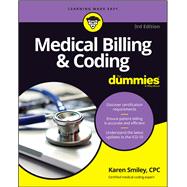The definitive guide to starting a successful career in medical billing and coding
With the healthcare sector growing at breakneck speed—it’s currently the largest employment sector in the U.S. and expanding fast—medical billing and coding specialists are more essential than ever. These critical experts, also known as medical records and health information technicians, keep systems working smoothly by ensuring patient billing and insurance data are accurately and efficiently administered.
This updated edition provides everything you need to begin—and then excel in—your chosen career. From finding the right study course and the latest certification requirements to industry standard practices and insider tips for dealing with government agencies and insurance companies, Medical Billing & Coding For Dummies has you completely covered.
- Find out about the flexible employment options available and how to qualify
- Understand the latest updates to the ICD-10
- Get familiar with ethical and legal issues
- Discover ways to stay competitive and get ahead
The prognosis is good—get this book today and set yourself up with the perfect prescription for a bright, secure, and financially healthy future!








